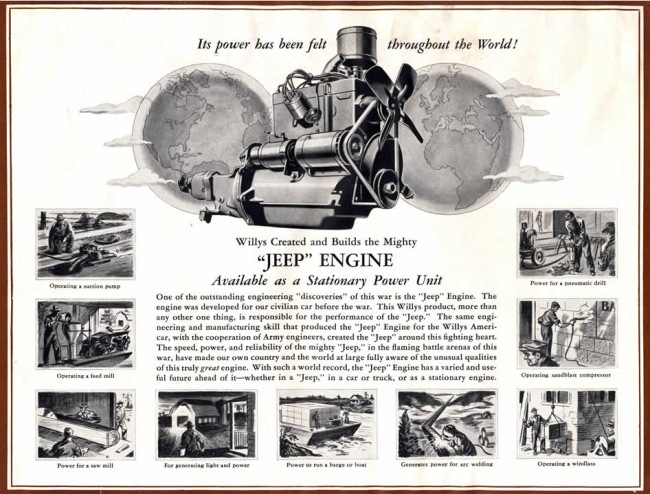This ad appeared in the September 5, 1946, issue of the Toledo Blade. The civilian jeep was barely a year old, yet Sears was already offering replacement engines and other parts. That’s because part of Willys-Overland’s strategy, as early as 1944, was to push the engine apart from the jeep. The company highlighted this during their 1944 annual report (a page of which is featured below this ad).
Page from the 1944 Willys Overland Annual Report:



Dave,
There is an interesting story behind the early Sears Jeep engines. I just finished writing it for the next Dispatcher magazine. In a nutshell, the executives at the Wilson Foundry (they cast and assembled Jeep engines) saw a money making opportunity to sell surplus engines they had on hand. The interesting thing is, they passed the opportunity on to their wives. Most of the 7 wives invested $3,000. In return, they were able to split a $40,000 profit in 1946. Sears bought 1,000 engines from them that year.
Bill
Need to buy a half dozen before Sears closes
Bill Norris: That sure is interesting! I don’t know how often this occurred, but back in the 1870s my great great grandmother was handling the purchase and sale of hers and her husband’s real estate and also had a large amount of company stock (companies my g. g. grandfather had co-founded) in her name as well (she was a book keeper before they married). I’ve always assumed this was a risk reduction in case he was sued. By the 1940s, with the income tax in place, the situation you describe could have been an income tax reduction strategy. I look forward to the article!
Bill: Right? The price is right! 🙂
Dave,
Its interesting you mention that. As a matter of fact I found this out because the IRS brought suit against the husbands stating they must have financially benefitted from the arrangement. In the end, the courts sided with the ladies and said they were indeed separated enough that the men did not gain from this. It must have been a tax strategy back then.
By the way, the ladies paid a $50 fee to obtain the motors, so you can see that it was pretty lucrative.
Bill
I love pursing history. So many interesting stories to tell!